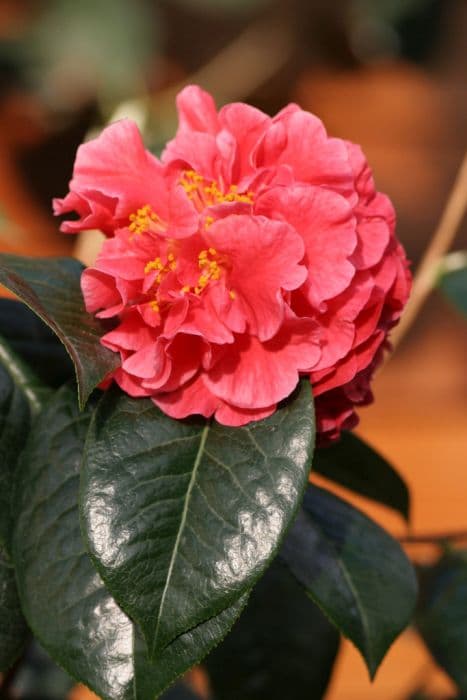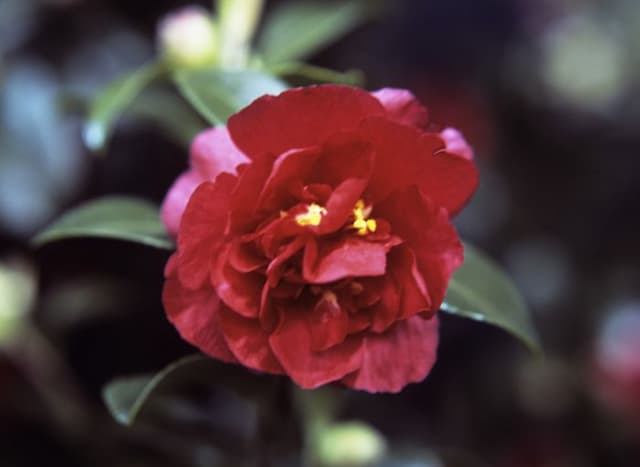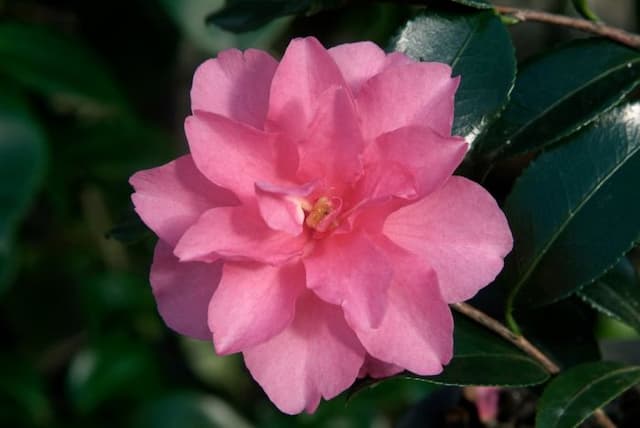Japanese camellia Camellia japonica 'Adolphe Audusson'

ABOUT
Camellia japonica 'Adolphe Audusson' is a beautifully ornate plant known for its striking flowers and lush, glossy foliage. This variety of camellia is characterized by its large, showy blooms that make it a standout in any garden setting. The flowers boast a rich, deep red hue, with petals that are typically broad and slightly overlapping, creating a peony-like form that is quite exquisite to behold. Each flower possesses a velvety texture and may have a dramatic contrast of bright yellow stamens at the center, adding to its ornamental appeal. The leaves of 'Adolphe Audusson' contribute greatly to the plant's overall aesthetic, being dark green, leathery, and shiny, adding a rich backdrop to the vibrant flowers. The foliage is arranged alternately along the stems, with each leaf featuring a finely serrated edge, tapering to an elegant point. The shape of the leaves is elliptical to slightly oval, which harmonizes with the plant's form. In addition to its visual beauty, the plant is also appreciated for its hardiness and relative ease in cultivation, fitting well into many garden designs and settings. With its timeless elegance, Camellia japonica 'Adolphe Audusson' is a cherished classic among garden enthusiasts and is often associated with Southern gardens where it thrives and exudes old-world charm.
About this plant
 Names
NamesFamily
Theaceae
Synonyms
Japanese Camellia, Adolphe Audusson Camellia
Common names
Camellia japonica 'Adolphe Audusson'.
 Toxicity
ToxicityTo humans
The Japanese Camellia is generally recognized as non-toxic to humans. Therefore, accidental ingestion of the Japanese Camellia 'Adolphe Audusson' typically does not lead to poisoning or serious symptoms in humans.
To pets
The Japanese Camellia is generally considered to be non-toxic to pets as well. Ingesting parts of the Japanese Camellia 'Adolphe Audusson' is unlikely to cause poisoning or significant adverse health effects in pets.
 Characteristics
CharacteristicsLife cycle
Perennials
Foliage type
Evergreen
Color of leaves
Green
Flower color
Red
Height
6-10 feet [1.8-3 meters]
Spread
6-10 feet [1.8-3 meters]
Plant type
Shrub
Hardiness zones
7
Native area
Japan
Benefits
 General Benefits
General Benefits- Ornamental Value: The Camellia japonica 'Adolphe Audusson' offers striking red flowers that enhance the aesthetic appeal of gardens and landscapes.
- Long Blooming Season: This variety blooms for an extended period, typically from late winter through spring, providing color when many other plants are dormant.
- Evergreen Foliage: It retains its glossy, dark green leaves year-round, offering constant visual interest and structure in garden designs.
- Drought Tolerance: Once established, it has a certain degree of drought tolerance, reducing the need for frequent watering.
- Shade Tolerance: This plant can thrive in partial shade, making it suitable for understory planting and areas with filtered sunlight.
- Cold Resistance: It is relatively cold-hardy, which allows it to be grown in regions with cooler climates, although protection may be necessary in the coldest areas.
- Versatility: It can be used in a variety of landscape applications, including specimen planting, hedges, and foundation plantings.
- Wildlife Attraction: While not its primary benefit, it may attract pollinators such as bees during its blooming season.
- Low Maintenance: Requires minimal pruning and upkeep once established, making it suitable for gardeners of all skill levels.
- Privacy Screen: Can be planted as a dense shrub, forming an effective privacy screen or windbreak for a property.
- Cultural Significance: It has been cultivated for centuries and is often associated with elegance and grace in horticulture.
 Medical Properties
Medical PropertiesThis plant is not used for medical purposes.
 Air-purifying Qualities
Air-purifying QualitiesThis plant is not specifically known for air purifying qualities.
 Other Uses
Other Uses- Camellia petals can be used in craft projects, such as making natural dyes for fabrics or paper, lending a soft pink to reddish hue depending on the concentration.
- Dried Camellia petals can serve as a decorative element in homemade soaps, offering a touch of natural color and a light floral fragrance.
- Camellia blossoms can be pressed and included in resin jewelry, preserving the beauty of the flower in pendants and earrings.
- The waxy leaves of the Camellia can be polished and used as a natural adornment in floral displays, adding glossy greenery that lasts longer than most foliage.
- Camellia petals can be used to create unique bookmarks by laminating them within clear sheets, making an attractive gift for book lovers.
- When dried, Camellia flowers can be incorporated into potpourri mixes, contributing to the visual appeal and aroma of the blend.
- Camellia wood, being hard and durable, can be carved into small objects like buttons or beads for crafts and garments.
- Camellia seed oil, also known as tea seed oil, is used for seasoning and cooking in some culinary traditions, adding a unique flavor to dishes.
- The spent blooms of the Camellia can be used as a natural mulch or compost material, enriching the soil as they decompose.
- Camellia flowers can be floated in bowls of water to create simple yet elegant table centerpieces for events and home decor.
Interesting Facts
 Feng Shui
Feng ShuiThe Camellia is associated with positive Feng Shui energy, symbolizing love, affection, and admiration. To enhance romance or show respect to someone, you can place Camellias in the southwest area of your garden or home.
 Zodiac Sign Compitability
Zodiac Sign CompitabilityThe Camellia is not used in astrology practice.
 Plant Symbolism
Plant Symbolism- Love and Affection: The Camellia japonica, commonly known as the Camellia, is often associated with deep desire, love, and affection, making it a popular choice for romantic occasions.
- Admiration: Gifting Camellia flowers also symbolizes admiration towards someone and is often used to convey a message of respect and positive feelings.
- Perfection and Excellence: Due to its perfect symmetry and long-lasting blooms, the Camellia represents perfection and striving for excellence in many cultures.
- Faithfulness and Longevity: The Camellia's enduring nature is symbolic of faithfulness and the longevity of a relationship, signifying a strong bond that stands the test of time.
- Devotion: Particularly red Camellias, like 'Adolphe Audusson', symbolize deep devotion and a strong passionate love.
 Water
WaterFor the Japanese Camellia, it's essential to maintain moist soil, particularly during dry spells, without making it waterlogged. Water the plant deeply about once a week by applying roughly 1-2 gallons of water, depending on the size of the plant and the weather conditions. During hot or windy weather, you may need to water twice a week, while in cooler or rainy periods, reduce the frequency accordingly. Always check the top inch of the soil before watering; if it feels dry, it's time to water. Keep in mind that container-grown Camellias may require more frequent watering than those planted in the ground.
 Light
LightJapanese Camellias thrive in partial shade with some morning sun and afternoon protection from intense sunlight, which can scorch the leaves. The ideal spot is one that offers dappled sunlight through the branches of taller trees or a location with bright, indirect light. Avoid placing the Camellia in full sun, especially in hotter climates, as this can lead to stress and poor blooming.
 Temperature
TemperatureJapanese Camellias prefer moderate temperatures and can commonly survive within a range from about 20°F to 100°F, although they truly thrive when temperatures stay between 40°F to 85°F. They are not tolerant of prolonged temperatures below 20°F and can suffer cold damage if exposed to extreme cold without protection. During hot weather, ensure they have ample shade to avoid heat stress.
 Pruning
PruningPrune Japanese Camellias for shape, size control, and removal of dead or weak wood, and do this just after they finish blooming, typically in late winter or early spring. This timing allows the plant to set buds for the next season's flowers. Thinning out of dense growth can also improve air circulation and light penetration, which helps prevent disease.
 Cleaning
CleaningAs needed
 Soil
SoilThe best soil mix for Camellia, commonly known as the Japanese Camellia, is well-draining with plenty of organic matter, such as a mixture of 50% peat and 50% bark compost with some grit or perlite for additional drainage. The ideal soil pH for Camellia should be slightly acidic, ranging from 5.5 to 6.5.
 Repotting
RepottingJapanese Camellias typically require repotting every 2-3 years to ensure healthy growth. Repot in early spring or after flowering has ceased, using the appropriate acidic soil mix mentioned previously.
 Humidity & Misting
Humidity & MistingJapanese Camellias thrive best in moderate to high humidity conditions, ideally between 40-60%. They benefit from consistent humidity levels, especially during their growth period in spring and summer.
 Suitable locations
Suitable locationsIndoor
Place in bright, indirect light and keep soil moist.
Outdoor
Plant in partial shade, shelter from strong winds.
Hardiness zone
7-9 USDA
 Life cycle
Life cycleCamellia japonica 'Adolphe Audusson', commonly known as the Japanese camellia, begins its life as a seed, which upon finding the right conditions, germinates and develops a root system and a shoot that breaches the soil surface. The seedling stage follows, characterized by initial leaf production and gradual development into a young plant; during this stage, the plant is particularly sensitive to environmental conditions. As it enters the juvenile phase, the plant exhibits more robust growth, developing a stronger stem structure, more leaves, and begins to take on the characteristic shape of a camellia shrub. The plant reaches maturity after several years, at which point it can produce its striking red flowers typically in the late winter to early spring; flowering marks the beginning of the reproductive stage, where pollinated flowers can set seed for the next generation. Camellias can live for many years, often several decades, and will continue to grow and produce flowers annually during their lifespan. Eventually, the plant will reach a senescence phase where growth slows, fewer flowers are produced, and it becomes more susceptible to environmental stresses, leading to the end of its life cycle.
 Propogation
PropogationPropogation time
Spring-Early Summer
The Camellia japonica 'Adolphe Audusson', commonly known as the Japanese camellia, is best propagated through semi-hardwood cuttings taken in late summer. The cutting should be about 4 to 6 inches (10 to 15 centimeters) long with several leaves remaining at the top. Dip the cut end into rooting hormone to encourage root development and plant the cutting in a pot with well-draining soil, such as a mix of peat and perlite. The pot should then be placed in a warm area with indirect sunlight and kept uniformly moist. Covering the pot with a plastic bag can help maintain humidity, which is beneficial for the rooting process. Roots typically develop within several weeks, after which the cutting can be gradually acclimated to less humid conditions before being transplanted outdoors.









